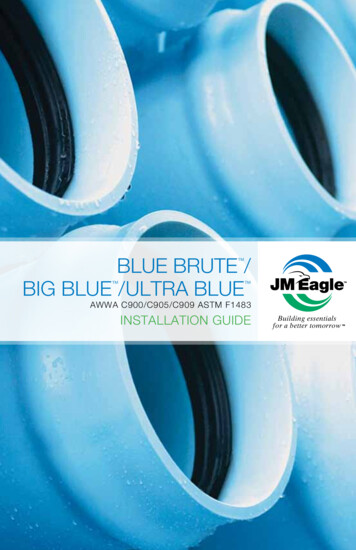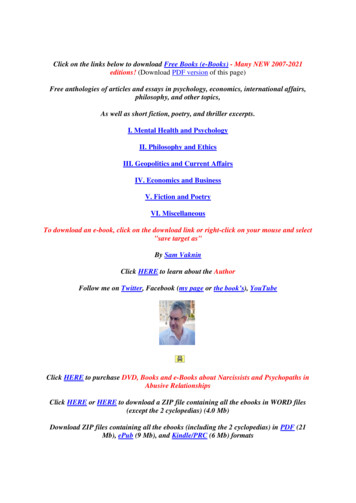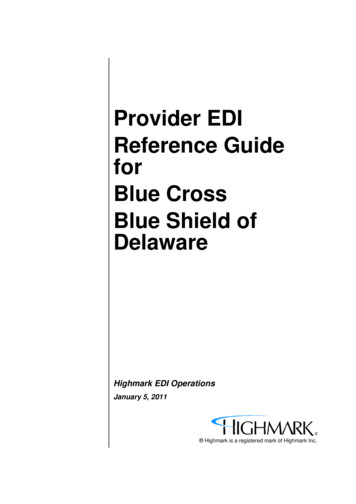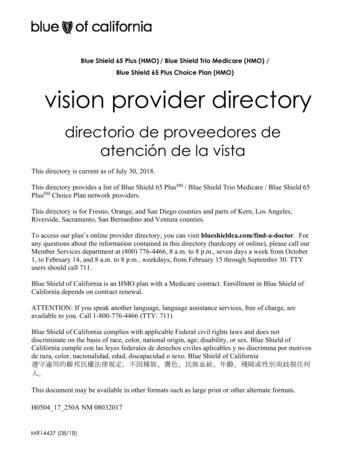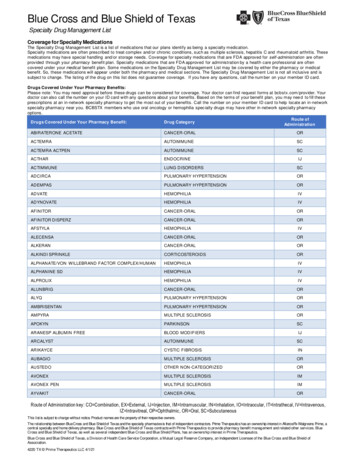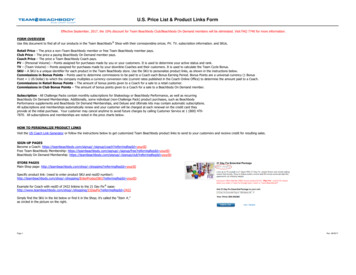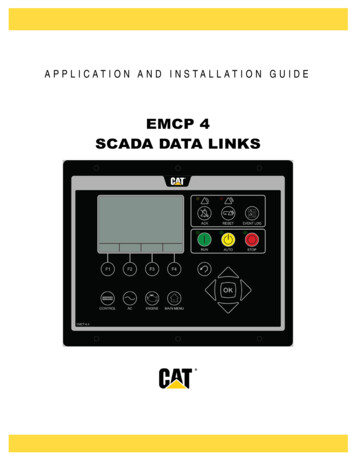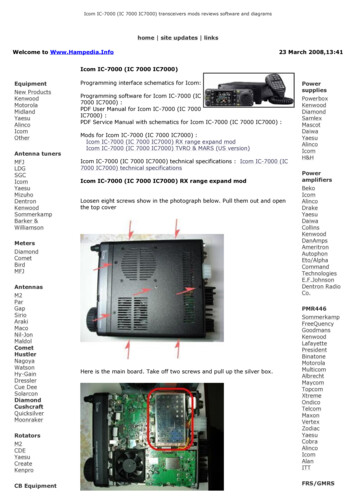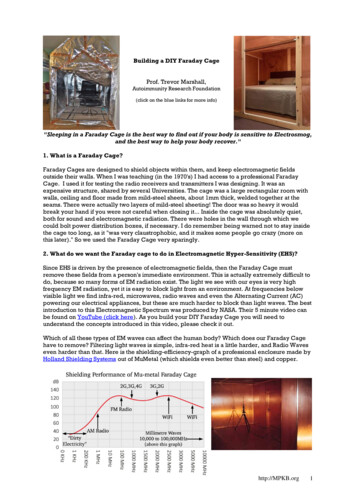
Transcription
Building a DIY Faraday CageProf. Trevor Marshall,Autoimmunity Research Foundation(click on the blue links for more info)"Sleeping in a Faraday Cage is the best way to find out if your body is sensitive to Electrosmog,and the best way to help your body recover."1. What is a Faraday Cage?Faraday Cages are designed to shield objects within them, and keep electromagnetic fieldsoutside their walls. When I was teaching (in the 1970's) I had access to a professional FaradayCage. I used it for testing the radio receivers and transmitters I was designing. It was anexpensive structure, shared by several Universities. The cage was a large rectangular room withwalls, ceiling and floor made from mild-steel sheets, about 1mm thick, welded together at theseams. There were actually two layers of mild-steel sheeting! The door was so heavy it wouldbreak your hand if you were not careful when closing it. Inside the cage was absolutely quiet,both for sound and electromagnetic radiation. There were holes in the wall through which wecould bolt power distribution boxes, if necessary. I do remember being warned not to stay insidethe cage too long, as it "was very claustrophobic, and it makes some people go crazy (more onthis later)." So we used the Faraday Cage very sparingly.2. What do we want the Faraday cage to do in Electromagnetic Hyper-Sensitivity (EHS)?Since EHS is driven by the presence of electromagnetic fields, then the Faraday Cage mustremove these fields from a person's immediate environment. This is actually extremely difficult todo, because so many forms of EM radiation exist. The light we see with our eyes is very highfrequency EM radiation, yet it is easy to block light from an environment. At frequencies belowvisible light we find infra-red, microwaves, radio waves and even the Alternating Current (AC)powering our electrical appliances, but these are much harder to block than light waves. The bestintroduction to this Electromagnetic Spectrum was produced by NASA. Their 5 minute video canbe found on YouTube (click here). As you build your DIY Faraday Cage you will need tounderstand the concepts introduced in this video, please check it out.Which of all these types of EM waves can affect the human body? Which does our Faraday Cagehave to remove? Filtering light waves is simple, infra-red heat is a little harder, and Radio Waveseven harder than that. Here is the shielding-efficiency-graph of a professional enclosure made byHolland Shielding Systems out of MuMetal (which shields even better than steel) and copper.http://MPKB.org1
On the graph’s bottom axis is listed the frequency of the EM waves outside the Faraday Cage (FC)in kiloHertz (KHz) and megaHertz (MHz), and on the vertical scale is plotted the amount (in dB,Decibels) by which those waves are reduced in strength (power level) (attenuated) inside theFaraday Cage (Wikipedia has a good explanation of Decibels).Why does the attenuation of the professional cage fall towards the bottom and top of its frequencyrange? Why are some waves harder to attenuate than others? How can we make sure our DIYFaraday Cage stops all the fields of biological importance?Well, higher frequencies have shorter wavelengths (remember the NASA video?) and can easilyget through holes and defects in the ‘skin’ of the FC structure. For example, at WiFi frequencies, aslit just 2.4 inches (6cm) long will allow waves to pass through it unhindered. At even higher(millimetre) microwave frequencies, a 4mm hole is enough to allow signals to pass through. The77GHz radar which is part of an automobile’s “Driver Assist” technology will easily pass through a4mm hole (is your bedroom facing a street or garage?). So it becomes much harder to build aFaraday Cage which provides protection (attenuation) as the incoming frequency increases. Butprovided we make the cage out of a material which short-circuits the electric field, it is not difficultto shield against the frequencies above 500MHz (which contains the 4G, 3G and 2G cellphone andWiFi fields). Silver threads in clothing can be made to do a good job at these higher frequencies,as can virtually any solid metal.The performance drop at lower frequencies (at the left of the graph) is less well understood, yetit is key to obtaining the shielding a human body needs. We call the waves “ElectroMagnetic”because they possess both an electric voltage and a magnetic flux component as they travelthrough space. At the lowest frequencies we usually measure the magnetic field strength inGauss or Tesla, and at higher frequencies we measure the electric field in Volts per Metre.Remember that NASA told us the wavelength gets longer as the frequency falls? At 900MHz (4Gfrequencies) the wavelength is about 13 inches, 33cm. We adjust the length of the whip antennaon a measuring instrument to one quarter of this length, 3.2inches, to obtain an optimalreference measurement of the electric-field component. An FM Radio, at a frequency 10 timeslower (100MHz) uses a whip antenna about 30” long. But at lower AM Radio frequencies (1MHz)the wavelength has increased to 300 metres (328ft) and it is impossible to use a 82ft collapsiblewhip antenna to make sure we intercept all the electric signal! The magnetic component ofthese lower frequencies dominates the signal being intercepted by 6ft bodies, such as a humanbeing. AM Radio sets are consequently fitted with a ferrite rod to receive the magneticcomponent of the radio waves (if the radio set covers short-waves then a whip antenna is oftenprovided to use on its short-wave frequency bands).A magnetic material (such as steel or MuMetal) is used in the walls of a professional FaradayCage as it attenuates the magnetic component of waves at the lower frequencies. Yet themanufacturer of the cage (above) still had considerable difficulty in maintaining shieldingperformance at AM Radio and lower frequencies. This is why the professional Faraday Cage Iused in the 1970’s had two layers of mild-steel around it, rather than the single relatively-thinlayer of MuMetal used in the Holland implementation.3. Our DIY breakthrough allows Aluminum or Copper instead of Steel wallsThe average handyman cannot easily weld sheets of mild-steel into walls and floors, and evensoldering the MuMetal sheets from Holland Shielding Systems is difficult. To design a FaradayCage using Aluminum foil or Copper mesh, we reachedback to some electrical transformer designs I did in the1970’s. In transformers the problem is reversed, there is amagnetic flux in the structure, and we don’t want that flux toleak into the environment, so I used to wrap a copper “fluxband” around my transformers. This worked well, as long asthe resistance of the flux-band was kept very low. Thanks toHendrik Lorentz, who defined Reciprocity in 1896, the fluxband principle also applies in reverse, so that externalmagnetic fields are reduced inside the band. What we do inhttp://MPKB.org2
our DIY Faraday Cage design is to put a continuous sheet of highly conductive material aroundthe entire body of the DIY Faraday Cage, so that AM radio signals, and other lower frequency EMsources (such as ‘Dirty Power’) are attenuated or eliminated by the current flowing in that ‘FluxBand.’4. By how much does the Electrosmog radiation have to be reduced?This really involves answering two questions – what is the level of waves we need to achieve sothat a human body can function properly, and what are the strengths and frequencies of theincoming radiation we need to attenuate from our homes, our workplaces, and our bedrooms?That question introduces three more elements of complexity – the importance of time, humanactivity, and the lack of definition by the medical community as to what defines “functionproperly” or “Health.” The first two factors were clarified when our research found that if aperson is to recover from EHS, sleep is the most important time to be shielded. Indeed, most ofmy colleagues only use their Faraday Cage for sleep and relaxation, when our bodies needmaximum protection.Bioinitiative 2012 noted the level of –37dBm as that where studies have demonstrated measurableresponse in humans, and suggested –47dBm as a precautionary maximum level. But we havebeen able to devise experiments which have proven far more sensitive than those used by mostother research groups. If you watch my presentation at the Autoimmunity Congress in Lisbon, Iexplain that our own research has shown that humans who are EM-sensitive can identify thepresence of Radio Signals to below -90dBm (Wikipedia has a good explanation of the term ‘dBm’).The amplitude of waves in a typical 2018 home environment ranges from -50dBm to -30dBm. Thusa Faraday cage needs to attenuate the waves in a home by at least 40dB to 60dB (10,000 to onemillion times in amplitude) in order to ensure that a wave will remain undetectable.5. What if the Faraday Cage makes me ‘sick’, what do I do then?As I hinted above, some EHS sufferers experience a temporary increase in their symptoms whenstarting to use shielding, including a Faraday Cage. In actuality, fluctuations of the fields aroundthem in their daily lives also modulate their symptoms but it is really hard to pin down any causeeffect relationship when there is a delay of hours from exposure-change to a complete immunesystem response, and a recovery period often spanning days. For more insight into thisphenomenon, immunopathology, please read my paper “Electrosmog and Autoimmune Disease”From a practical point of view, it is best to only sleep in the Faraday cage for periods which arerelatively comfortable. For some that will be an hour or two, for some it will be a full night’s sleep.As the months go by, and the body begins to recover, we have found even the most sensitive folkwill start to get a good night’s sleep, and, eventually, will regain an EMF tolerance when out of thefully shielded environment.6. The most important decision to make when planning a DIY Faraday Cage.The most important decision an EHS patient can make is not to cut corners when implementingelectromagnetic shielding. When I say that “we have tested the following materials and they workwell” I also imply that we have tested many times that number of materials which have not workedwell.We have found that the Attic Foil aluminum product from Texas has worked well for several of ourmembers. It is made from two very, very, thin aluminum surfaces applied to each side of a strong,yet flexible, polymer sheeting. The resistance of the layers is quite low, at least until they havebeen flexed repeatedly, such as occurs in a door flap. It is best to assume the door flap will needto be replaced every few months. This product is unique by comparison with the mylar film andevaporated-metal products which look the same, but which do not have a low resistance when youmeasure their surfaces. There are tiny holes punched into the foil for ventilation, these do notmeasurably affect the shielding performance. The product is available in a variety of widths. Thehttp://MPKB.org3
cage at the top-left of this document uses this foil, and it achieves an attenuation greater than 60dBnot only at all the microwave frequencies, but also in the AM broadcast band.As you can see from the photo at the right-top, a very fine semi-transparent copper mesh is alsoavailable. The two sizes which we have tested are the 145mesh by 0.0022 copper and the 100meshby 0.0045 copper. The second is nearly 3 times the weight of the first, and even though it is lessexpensive, you should remember that the a 4ftx100ft roll of the 100mesh weighs about 55 poundswhen UPS delivers it to you. Attenuation of both at 40GHz is above 40dB, at 4GHz (4000MHz) itsattenuation risen beyond 55dB and remains above that throughout the 2G, 3G and 4G bands.Under no circumstances should copper ‘insect screening’ be used. Microwaves travel straightthrough its large holes, and its shielding effectiveness at 2G, 3G, 4G and WiFi frequencies is wellbelow 40dB.The Flux Strap should be one continuouslength of foil or mesh, with only one seam.I prefer to place the seam underneath thefloor boards, so it is under constantpressure. Use a folded seam as shown atright. A little copper tape along each edgeof the seam will keep dirt out of the contactregion. Although the minimum overlap isshown as 4” I personally prefer a foot ormore of overlap.The copper mesh loop can be cut if absolutely necessary, with a seam like this held underpressure between two timber or metal spars. This construction was used in the whole-bedroomFaraday Cage shown above.7. The door flapA glance at the selection of doors typically used for commercial Faraday Cages shows that theyare out of reach for DIY construction. Their metal construction makes them much to heavy to besupported by a DIY structure, either piping or wood.We have found the best door construction is formed by a flapwhich is pulled to a U-Shaped frame around which the outersurface of one end of the flux band is wrapped. You can see theU-shaped frame here, with metal strips attached to the insidesurface. Three pieces of 1” x 1” aluminum angle (which arefairly rigid) each have two powerful neodymium magnetsbolted to them. The magnetic force from the magnets pullsthrough the aluminum angle (about 1/16”), the flap, the outershell of the flux band to the u-shaped metal strips fastened tothe door frame, holding them all firmly together without any slitsor gaps which would destroy high-frequency performance,while maintaining low contact resistance necessary for lowfrequency (magnetic) performance. In this way we produceanother low-resistance path at the ends of the structure, creatingadditional ‘flux bands’ to shield magnetic fields coming into theends of the Faraday Cage.Plastic ties are used to hold the u-shaped frame wood to thepiping of this structure. Similarly, the ties are used to hold thefloor boards, 3-ply sheets 2ft x 4ft, in place between the bottompipes of the frame. Gaffer tape is u
explain that our own research has shown that humans who are EM-sensitive can identify the presence of Radio Signals to below -90dBm (Wikipedia has a good explanation of the term ‘dBm’). The amplitude of waves in a typical 2018 home environment ranges from -50dBm to -30dBm. Thus a Faraday cage needs to attenuate the waves in a home by at least 40dB to 60dB (10,000 to one million times in .
